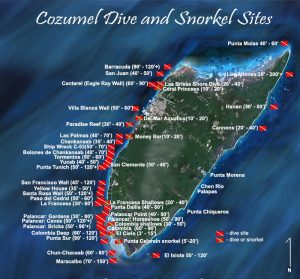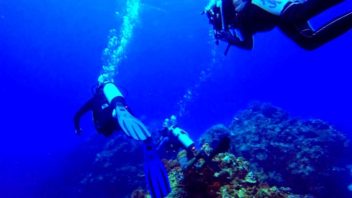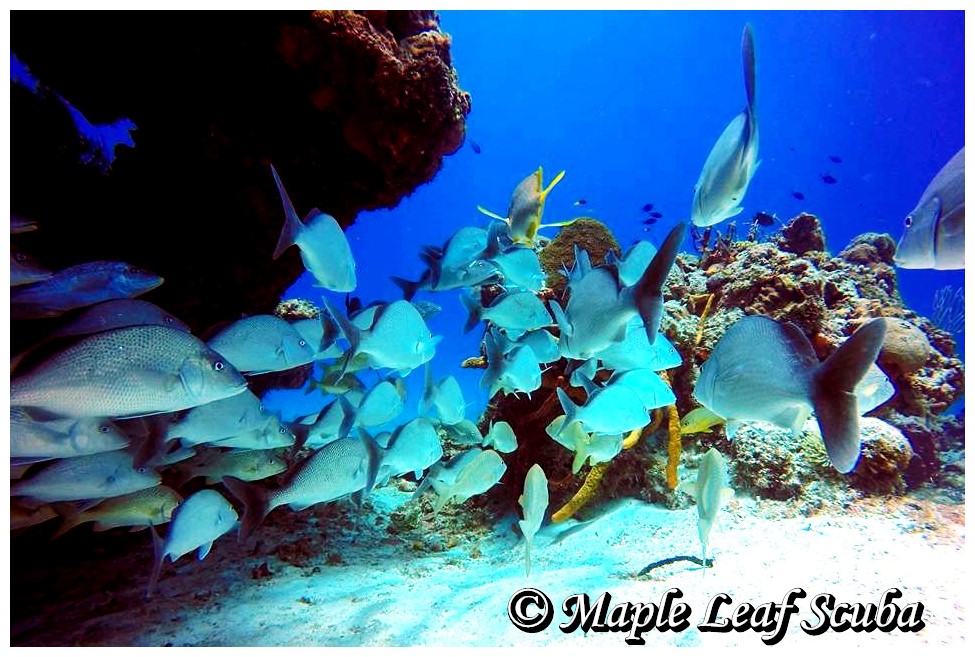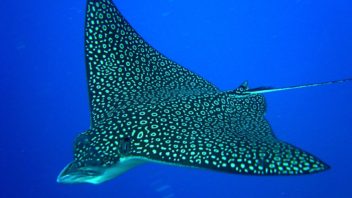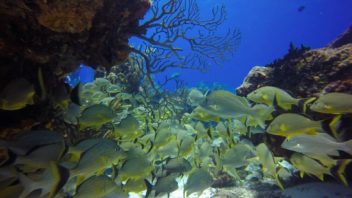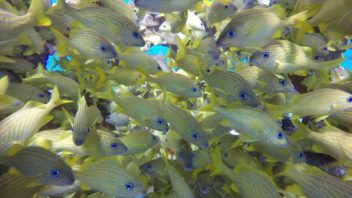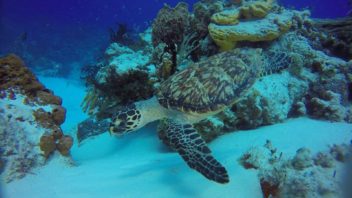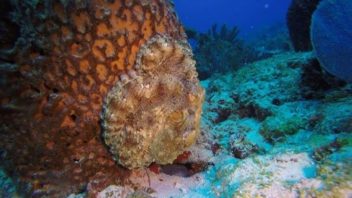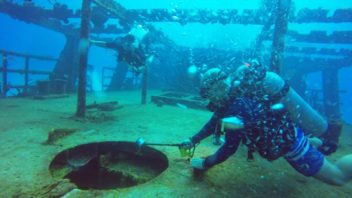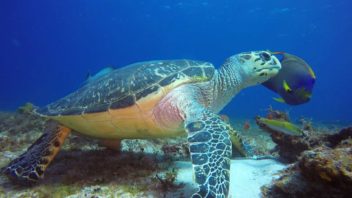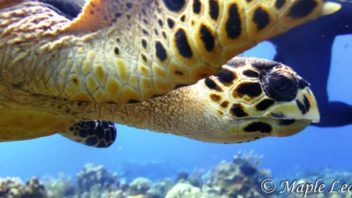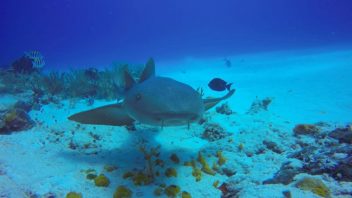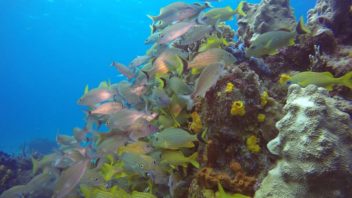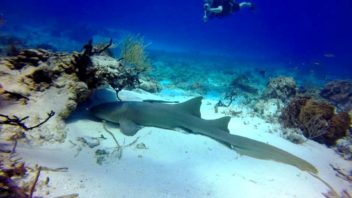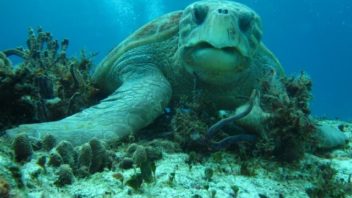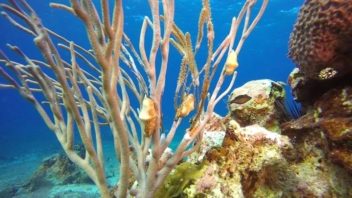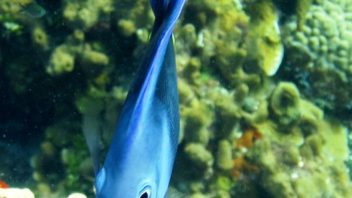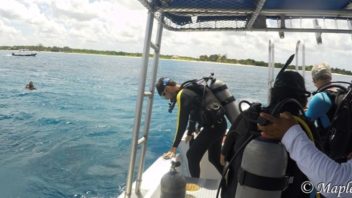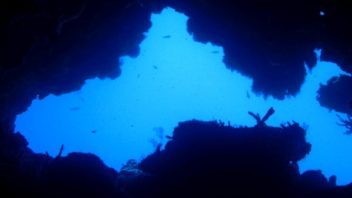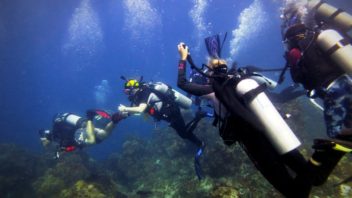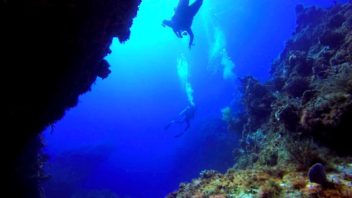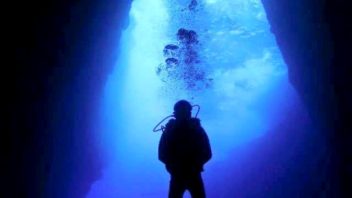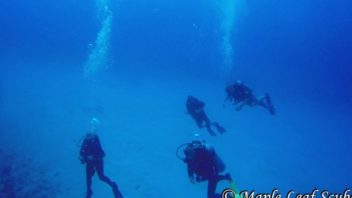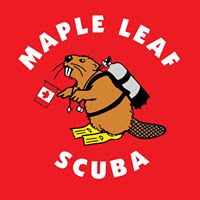Barracuda
Depth: 90’-120’
Conditions: Strong currents expected; windy with surface chop
Experience level: Advanced divers only
This dive, the most northerly dive site, is rarely visited. It is a flat strip reef with sand, sloping into the depths. The big attraction here is the chance to see large pelagic such as barracuda, jacks, eagle rays, turtles and sharks.
It is difficult to photograph any marine life here as the currents are extremely strong.
San Juan
Depth: 40’-50’- you can go deeper than this towards the drop off
Conditions: Strong currents expected; windy with surface chop
Experience level: Advanced divers only
Located in the North, this site is usually done as a second dive after Barracuda or Cantrel. This area is dominated by huge finger coral, lettuce coral and sponges. There are also a few ledges and overhangs where you will see french grunts and schoolmasters. In addition, along the reef, you will see thousands of damselfish and red seaweed.
When the sea is calm, this dive can make for a really beautiful dive.
Cantarel (Eagle Ray Wall)
Depth: 40’-100’
Conditions: Strong currents expected; windy with surface chop
Experience level: Advanced divers only
Located in the North, this site is visited more often when the Eagle Rays migrate through Cozumel. This usually happens during mid January thru to the beginning of March. It is a wall dive and should be approached from the shallows.
At times, it is possible to see 20 rays pass by the wall at about 80’ or thereabout.
Villa Blanca Wall
Depth: 40’-120’
Conditions: Strong currents and some surface chop is possible
Experience level: Intermediate
This is a wall dive which slopes steeply. It can be done from shore though not advised. The swim out from shore takes approximately 15 minutes which makes it a short dive overall.
The reef gets lots of current so it is low profile. The sponges and coral are in great shape. You will see lots of barrel sponges, basket sponges, and gorgonian throughout.
From a boat, this is a nice dive when the currents are not too strong. You can start from the ferry pier and drift north along the wall.
Paradise Reef
Depth: 30’-40’
Conditions: Light to moderate
Experience level: Beginner
This is the first reef when entering the Marine Park. It is a popular second dive and also a popular night dive.
The current typically runs from South to North. The dive usually starts across from the entrance of the local marina and drifts north. There are a few coral ridges that parallel the shore line.
You will get to see schools of grunts, snapper, sergeant majors and many queen angelfish. You can find various anemones and a variety of sponges clinging to the coral heads. It is possible to see every kind of fish from the area here.
Las Palmas
Depth: 40’-70’
Conditions: Light to moderate
Experience level: Beginner
This is an easy dive and it is done as a second dive. The currents can change direction here.
The site is filled with brain coral, rope sponges and rough tube sponges. You can also see turtles, honeycombed cowfish, and parrotfish. Under the coral, you can find lobsters, angelfish and the occasional splendid toadfish.
Chankanaab
Depth: 35’-40’
Conditions: Mild
Experience level: Beginner
Located opposite Chankanaab Park this is an easy shallow dive. Most often completed as a second dive and can also be completed as a shore dive. Don’t expect the same visibility as other dive sites as often times there is some run-off from the local lagoon. It is sandy with small coral heads. Here you will see grunts, snappers, crabs, spotted moray eels and some french angel.
Ship Wreck C-53
Depth: 50’-80’
Conditions: Moderate current
Experience Level: Advanced
This wreck was sunk just off Charkanaab Park. The barge was sunk many years ago and has long since been overgrown with plenty of marine life and makes for a great Cozumel dive site. The barge measures 154 feet long, 33 feet wide and 40 feet high. The barge sits upright on the ocean floor. Expect to see plenty of large groupers and green moray eels.
Tormentos
Depth: 50’-60’
Condition: Strong Current
Experience Level: Intermediate
This dive site is usually done as a second dive. The reef is very healthy and colorful. The reef heads stand 20’-30’ high separated by sandy valleys and dunes pushed up by prevailing currents. You will find turtles, groupers, snappers, french grunts, nurse sharks and angel fish.
Yucab
Depth: 40’-50’
Condition: Moderate Current
Experience Level: Beginner
This dive site is done as a second dive. There is a huge concentration of marine life which covers this reef. There are sponges everywhere and of every color. The sand scoured overhangs offer refuge for lobsters, banded coral shrimps and the arrow crab. There are also large numbers of squirrelfish, angel and butterflyfish always swimming in pairs. This is a great site for photographers.
Punta Tunich
Depth: 50’-120’
Condition: Strong Current
Experience Level: Intermediate
This dive site is often done as a second dive. The northern end of this reef is the most interesting but it is best to approach it when there is a south-to-north current running. The wall at this end is near-vertical, with numerours caves and crevices. You will find lots of squirrelfish and pairs of angelfish here. A number of large green moray eels can be seen along this reef. You will also find some turtles hiding in the seagrass.
San Francisco
Depth: 40’-120’
Condition: Unpredictable Currents
Experience Level: Intermediate
This inclining sand and coral rubble sea bed slopes down over a mini drop –off where the reef crest tops 40 feet. The steep slope beyond this is strewn with coral rubble. The coral reef is made up of large clumps of varieties of brain coral, all topped off with sea fans and plumes. Pink vase sponges can be seen all over the reef and small schools of creole wrasse and bluehead wrasse are abundant in the constantly moving water along the reef.
Santa Rosa Wall
Depth: 45’-120’
Condition: Strong Current
Experience Level: Intermediate
The wall starts around 45’ feet and drops into the deep. This is a great wall dive and never disappoints. Eagle Rays and turtles are often seen here as well as groupers. There are some large tunnels which completely cut through the reef crest and the most northerly section has tunnels, caves, overhangs and underhangs and some sections of the wall become so steep they are near-vertical. This is a great multi-level computer dive.
Paso del Cedral
Depth: 40’-60’
Condition: Strong Current
Experience Level: Intermediate
This is a very good site for photographs. It is a great second dive. There are always lots of opportunities to photograph schooling fish. There are large groups of grunt and snapper, particularly the bluestriped grunt and the schoolmaster. The corals are fairly low-lying but there are some very interesting small corals. You will see plenty of nurse sharks and turtles on this site.
La Francesa
Depth: 30’-60’
Condition: Moderate
Experience Level: Beginner
Often completed as a second dive, this site is shallow. There is a large strip of coral along with patches of coral heads with a good variety of multicolored sponges and gorgonians. It is a great dive for photography with its splendid toad fish, butterfly fish and grouper. Southern stingrays, peacock flounders and various molluscs are to be found on the sand. There are good-quality corals and an abundance of fish and invertebrates.
Palancar Gardens
Depth: 30’-80’
Condition: Mild to moderate
Experience Level: Beginner
A great dive for those less experienced or for those who haven’t been diving in a few years to help build up confidence again. There are very colorful coral formations with a huge variety of species of coral jammed together with orange and purple sponges interspersed. Butterflyfish, angelfish, parrotfish and damselfish can always be seen. This dive should not be missed.
Palancar Horseshoe
Depth: 50’-90’
Condition: Strong current
Experience Level: Intermediate
Palancar Horseshoe gets it name from the u-shaped amphitheatre which can be seen from above. This dive site is similar to the other Palancar dive sites. It is usually done as a multi level dive and ends on top of the reef at 25 feet. It is famous for its coral and sponges; however, it is not rich with fish per Cozumel standards. There are many swim throughs which make it a fun dive.
Palancar Caves
Depth: 50’-120’
Condition: Moderate
Experience Level: Intermediate
Another popular Palancar dive site because of its deep buttresses, tunnels, caves and big caverns that sit along the edge of a sloping wall. Marine life is adundant with sightings of turtles, sharks and eagle ray’s during the season. Schooling fish, such as grunts and snapper, constantly appear. There are countless caves and canyons along this stretch of reef and you will never be able to see all of them even after several dives.
Palancar Bricks
Depth: 50’-90’
Condition: Mild to moderate
Experience Level: Intermediate
Another section of Cozumel's most spectacular reef and an excellent deep dive. Large coral formations rise from the white sandy bottom which easily slopes off into the blue abyss. Divers can wind in and around the large coral formations where marine life flourishes. But the stunning blue color of the abyss contrasted with the sandy bottom is what mesmerizes most divers visiting this area. Currents are usually mild and turtle, shark and eagle ray sightings are very common. Normally excellent visibility make this a photographer’s dream dive for those breathtaking "upward views".
Columbia
Depth: 60’-120’
Condition: Unpredictable current
Experience Level: Advanced divers only
This dive is a deep dive for experienced divers only. The snorkeling is delightful among the shallows but there can be a lot of surface swell which makes the snorkeling a little more uncomfortable. However, the clarity of the water makes up for that.
This site is littered with coral rubble and large coral blocks which become more pronounced coral buttresses as you swim further out to the edge of the wall. There are numerous large coral pinnacles made up of many different varieties of coral, interspersed with vividly colourful sponges. Here you will see large grouper, turtles and it has been reported that reef sharks cruise the deeper section of the wall.
The clarity of the water and the rich colors make it a very special place and it is listed as one of the top dive sites in the world.
Punta Sur (Devil’s Throat)
Depth: 90’-130’
Condition: Unpredictable current
Experience Level: Advanced divers only
An excellent multilevel dive for experienced divers only. Due to its southern location and exposure to prevailing tradewinds, topside conditions can be rough. This coupled with fast running midwater currents that can cause one to miss the dive site entirely. This site has two distinct sections and the air usage capability of the divers will determine if you can see both in one dive.
The most famous section, "Devil's Throat," starts inside a coral swim through. Divers descend into the opening of a dark narrow tunnel at 90 feet and takes you out into a sunlit opening at 130 feet on the wall overlooking the abyss. Eagle rays and sharks are occasionally spotted here. The other section of this site "The Cathedral," is a large cave opening with giant sponges that form a cross in the ceiling of the cave where light passes through. Very impressive photo if divers refrain from kicking up the sand.
Maracaibo
Depth: 70’-150’
Condition: Unpredictable currents
Experience Level: Advanced divers only
This is one of the southernmost dive sites on the island for recreational divers and is very exposed to current and topside surf due to its location. Because this southern end of the island drops off gradually, Maracaibo is a wall dive but a very deep one.
It is simply: a deep, wall dive with the top of the wall beginning around 100 feet hence limited bottom time unless multileveled. However, due to its more remote location, it's not uncommon to see schools of hammerheads or shoals of eagle rays as divers drift in the midwaters high above the ocean floor. This is not a dive for those needing to be "up close and personal" with the wall. Usually the midwater drift is where the action lies.

